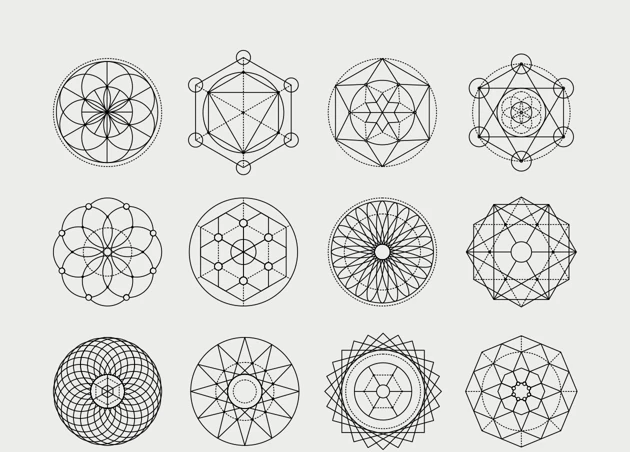Mandalas: Unlocking the Mysteries of Sacred Geometry and Symbolism
Have you ever found yourself captivated by the intricate beauty of a mandala? These mesmerizing designs have a rich history and hold deep spiritual significance in many cultures around the world. In this article, we will delve into the fascinating world of mandalas, exploring their origins, the sacred geometry that underlies their creation, and the profound symbolism embedded within their intricate patterns. Prepare to embark on a journey of discovery and understanding as we unravel the secrets of these ancient and enigmatic symbols.
The History of Mandalas
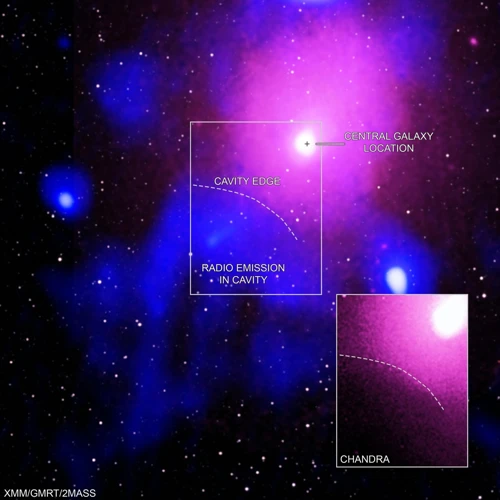
Mandalas have a rich and diverse history that spans cultures and civilizations. These intricate circular designs have been created and revered for thousands of years, dating back to ancient times. In various ancient cultures, from the Mayans of Central America to the Egyptians of ancient Egypt, mandalas have played a significant role in their art, architecture, and spiritual practices. The Mayans, known for their advanced mathematical knowledge and complex calendar system, incorporated mandala-like patterns in their elaborate pyramids, symbolizing their understanding of cosmic order and the mathematical principles that governed their world. Similarly, the ancient Egyptians used geometric patterns and mandala-like designs in the construction of their pyramids, temples, and other sacred structures. These sacred geometrical forms were believed to channel divine energy and serve as gateways to higher realms. The symbolism and significance of mandalas have transcended time and continue to intrigue and inspire us today. For more information on the connection between mathematics and ancient architecture, you can explore sacred geometry in ancient architecture.
Origins in Ancient Cultures
The origins of mandalas can be traced back to ancient cultures, where they were deeply intertwined with spiritual and religious practices. In ancient Central America, the Mayans were known for their intricate artwork and advanced knowledge of mathematics. It is believed that the Mayans incorporated mandala-like patterns in their art and architecture as a way to symbolize their understanding of cosmic order and the interconnectedness of all things. The intricate designs found in Mayan temples and pyramids demonstrate their mastery of geometry and sacred proportions. The Egyptians, known for their magnificent pyramids and temples, also utilized geometric patterns reminiscent of mandalas in their architecture. These designs were believed to hold spiritual significance and were associated with the divine. The sacredness of mandalas in these ancient cultures showcases the universal human desire to connect with something greater than ourselves. To learn more about the mathematical intricacies of the Mayan pyramids and their significance, you can explore the mathematics of Mayan pyramids and ancient Central American civilization.
Spiritual Significance in Eastern Traditions
In Eastern traditions, mandalas hold profound spiritual significance and are considered powerful tools for meditation and self-discovery. In Hinduism and Buddhism, mandalas are used as aids in the pursuit of spiritual enlightenment. The creation and contemplation of mandalas are believed to bring about a deep sense of inner peace and unity with the universe. In these traditions, the mandala represents a sacred space where the spiritual and material realms merge. The intricate patterns and geometric shapes within the mandala symbolize the interconnectedness of all beings and the cyclical nature of existence. Mandalas are also used as visual representations of deities or cosmic forces, serving as focal points for devotion and worship. By meditating on a mandala, one can enter a state of heightened awareness and gain insight into the true nature of reality. For more information on the use of sacred structures in ancient Egyptian traditions, you can explore geometry in ancient Egyptian pyramids.
The Sacred Geometry of Mandalas
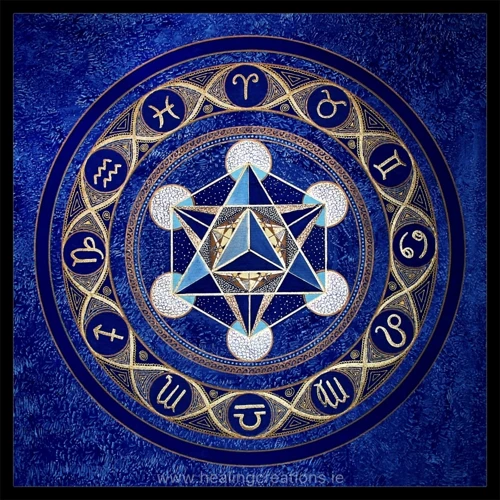
Mandalas are not merely beautiful designs; they are constructed using profound principles of sacred geometry. At the heart of mandalas is the circle, which serves as the foundation and core element of their design. The circle represents unity, completeness, and perfection, and it symbolizes the cyclical nature of life and the infinite cosmic order. Within the circle, mandalas often incorporate symmetrical patterns and geometric shapes that follow precise mathematical proportions. Symmetry is a key aspect of mandala design, with radial symmetry being particularly common. This means that the elements within the mandala are symmetrical around a central point, creating a harmonious and balanced composition. Mandalas often incorporate the concept of the golden ratio, a mathematical ratio found in nature that is considered aesthetically pleasing. The golden ratio, approximately 1.618, is believed to evoke a sense of beauty and harmony when applied in design. By incorporating these principles of sacred geometry, mandalas become more than just visually appealing patterns – they become powerful tools for meditation, contemplation, and spiritual connection.
The Circle as a Foundation
The circle serves as the fundamental shape and foundation of mandalas. Its significance lies in its symbolism of wholeness, unity, and eternity. The circle has no beginning or end, representing the cyclical nature of life and the interconnectedness of all things. It is often seen as a representation of the divine and the infinite. In mandalas, the circle acts as a container, holding and organizing the various patterns and symbols within its boundaries. It provides a central focal point from which the design radiates outward. The use of a circle in mandalas is not only aesthetically pleasing but also holds profound spiritual meaning. Its symmetrical and balanced nature creates a sense of harmony and equilibrium within the design. This foundational shape sets the stage for the intricate patterns and symbolism that unfold within the mandala’s sacred space.
Understanding Symmetry and Balance
Symmetry and balance are fundamental principles in the design of mandalas. These principles are derived from the concept of sacred geometry, which seeks to create harmonious and balanced compositions. Symmetry in mandalas is often achieved through radial symmetry, where the design elements are symmetrically arranged around a central point. This creates a sense of equilibrium and unity within the artwork. The use of geometric shapes, such as circles, squares, and triangles, further enhances the symmetry and balance of mandalas. By incorporating repetitive patterns and precise measurements, mandalas achieve a sense of order and harmony. The balance within mandalas extends beyond visual symmetry; it also represents a balance of energy and spiritual alignment. The careful placement of elements and colors within the mandala composition creates a sense of equilibrium and promotes a feeling of peace and tranquility. The understanding of symmetry and balance in mandalas is crucial in creating visually appealing and spiritually meaningful designs.
The Golden Ratio in Mandalas
When exploring the design principles of mandalas, one cannot overlook the presence of the Golden Ratio. The Golden Ratio, also known as the Divine Proportion, is a mathematical concept that appears in nature, art, and architecture across different cultures and time periods. This ratio, approximately 1.618, is believed to represent perfect harmony and aesthetic proportions. In mandalas, the Golden Ratio is often found in the arrangement of elements such as circles, petals, and geometric patterns. The use of the Golden Ratio in mandala design creates a sense of balance and visual appeal that resonates with our innate sense of beauty and order. It is through the application of this divine ratio that mandalas achieve their mesmerizing symmetry and captivating allure. Whether consciously incorporated or emerging naturally, the presence of the Golden Ratio in mandalas adds an extra layer of depth and harmony to these sacred symbols.
The Elements of Mandala Design
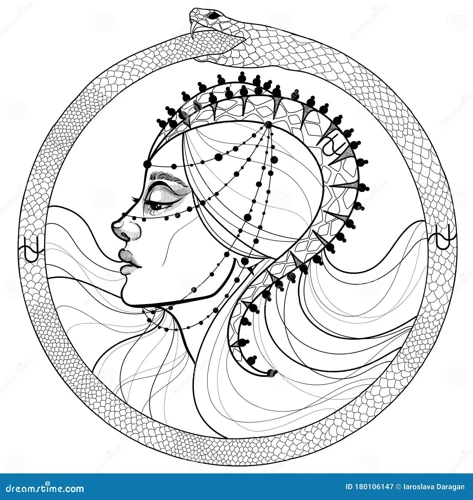
Mandala design consists of various essential elements that contribute to their intricate and captivating patterns. At the core of mandalas lies the center, which represents wholeness and unity. This central point acts as the focal point, around which all other elements radiate. The use of radial symmetry is another key element in mandala design. This symmetrical arrangement creates a sense of balance and harmony, as the patterns and shapes are mirrored and repeated throughout the design. The mandala is often divided into four quadrants, each representing different aspects of life or the journey of self-discovery. Layers of intricate patterns and shapes are carefully added, building upon one another to create a mesmerizing visual display. These elements work together harmoniously, producing a sense of unity and completeness in the design. Every aspect of the mandala’s composition contributes to its symbolic significance and aesthetic appeal, making it a powerful and captivating art form.
The Center: Symbol of Wholeness
At the heart of every mandala lies its center, a symbol of wholeness and unity. The center of a mandala holds significant importance as it represents the divine or the source of creation. It is often depicted as a focal point, radiating outwards with intricate patterns and designs. The center is where all the elements of a mandala converge, symbolizing the integration of body, mind, and spirit. This central point acts as a visual anchor, drawing the viewer’s attention and inviting them to explore the harmonious balance within the mandala. The center of a mandala can take various forms, ranging from a simple dot or a sacred symbol to a complex arrangement of geometric shapes. Regardless of its design, the center serves as a reminder of the interconnectedness of all things and the inherent unity that exists in the universe. As you gaze upon the center of a mandala, allow yourself to be reminded of your own inner wholeness and the infinite possibilities that lie within.
Radial Symmetry and the Four Quadrants
Radial symmetry is a fundamental principle of mandala design, creating a sense of balance and harmony. Mandalas are often divided into four quadrants, each representing different aspects of life, such as the physical, emotional, mental, and spiritual dimensions. In these quadrants, patterns and symbols are repeated symmetrically, radiating from the center of the mandala. This radial symmetry creates a visual equilibrium and a sense of unity. The four quadrants also represent the four elements – earth, air, fire, and water – and the four cardinal directions – north, south, east, and west. These elements and directions carry symbolic associations, adding depth and meaning to the mandala design. By incorporating radial symmetry and the four quadrants, mandalas not only create visually captivating artworks, but also reflect the interconnectedness of all aspects of life.
Layers of Patterns and Shapes
When examining the intricate designs of mandalas, one cannot help but be mesmerized by the layers of patterns and shapes that compose these sacred symbols. Each layer builds upon the previous one, creating a visually captivating and harmonious composition. The complexity of the design lies in the careful arrangement of various geometric shapes, such as circles, triangles, squares, and more. These shapes are meticulously repeated and interwoven, resulting in an intricate tapestry of interconnected patterns. The layers of patterns in a mandala often represent different aspects of life, spirituality, or the cosmos. They can symbolize the various stages of personal growth, the layers of consciousness, or the interconnectedness of all things in the universe. These intricate layers compel us to contemplate the depth and interconnectedness of our own existence. Through studying and appreciating the layers of patterns and shapes in mandalas, we gain insight into the profound wisdom and beauty that lies within these sacred symbols.
Symbols and Meanings in Mandalas
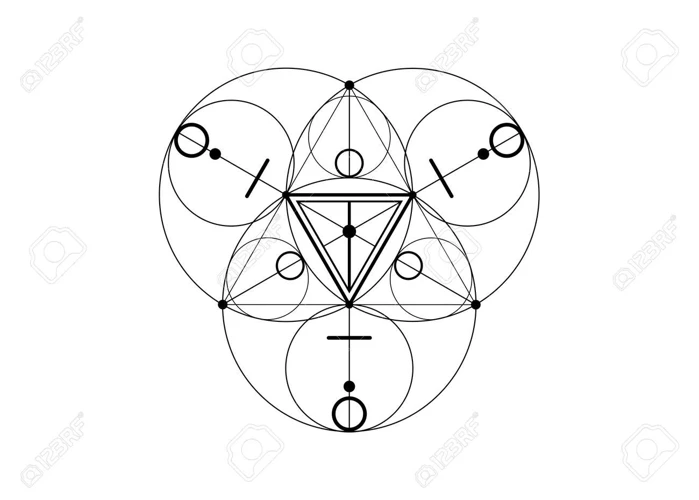
Symbols and meanings play a crucial role in the creation and interpretation of mandalas. Mandalas incorporate a wide array of symbols, each carrying its own significance and representing different aspects of life, spirituality, and the universe. Flora and fauna are commonly found in mandalas, symbolizing various elements of life and the cycle of creation and rebirth. Flowers represent beauty, growth, and the fleeting nature of life, while animals like birds and butterflies symbolize freedom, transformation, and spirituality. Geometric symbols, such as circles, squares, and triangles, are also prevalent in mandalas and hold universal knowledge and spiritual meanings. The circle, as the foundation of a mandala, represents wholeness, unity, and eternity. Triangles symbolize balance and harmony, while squares represent stability and grounding. Colors in mandalas also hold symbolic significance. Each color has its own energy and meaning, and the combination of colors in a mandala can convey various emotions, states of being, and aspects of the human experience. Exploring the symbolism and meanings behind the flora, fauna, geometric symbols, and colors in mandalas allows us to delve deeper into the layers of wisdom and spirituality embedded within these sacred designs.
Flora and Fauna: Representations of Life
Flora and fauna, the plant and animal life, hold significant symbolic meanings in mandalas. They portray the interconnectedness and harmony of all living beings within the natural world. In mandalas, floral elements such as blooming flowers, leaves, and vines represent growth, renewal, and the cycle of life. Different flowers may carry specific meanings; for example, the lotus flower symbolizes purity and spiritual enlightenment in many Eastern traditions. Similarly, fauna, including animals and insects, represent various qualities and characteristics. Birds often symbolize freedom, spirituality, and aspirations, while butterflies signify transformation and the fleeting nature of life. The presence of animals like elephants, lions, or dolphins can embody strength, wisdom, and the natural order of the animal kingdom. By incorporating these elements into the design of a mandala, individuals can connect with the profound vitality and beauty of the natural world, finding inspiration and guidance in their own journey towards self-discovery and wholeness.
Geometric Symbols: Unveiling Universal Knowledge
Geometric symbols are an integral part of mandala designs, and they hold deep symbolic meanings that unveil universal knowledge. These symbols are derived from sacred geometry, which is the study of mathematical principles that govern the universe. One such symbol commonly found in mandalas is the triangle, representing the elements of fire, water, and air, as well as the three stages of creation, preservation, and destruction. The square, with its four equal sides, represents stability, grounding, and the four cardinal directions. The hexagon, with its six sides, symbolizes harmony and balance. The spiral, often seen in mandala patterns, signifies evolution, growth, and the cyclic nature of life. Each geometric symbol in a mandala carries its own unique meaning, yet they collectively illustrate the interconnectedness of all things and the underlying order of the universe. By meditating on these geometric symbols within a mandala, one can tap into this universal knowledge and gain insight into the greater truths of existence.
Colors and Their Symbolic Significance
Colors play a vital role in the symbolism of mandalas, as each color holds its own unique significance and meaning. The choice of colors used in a mandala design can greatly impact its overall message and purpose. In mandala symbolism, blue represents tranquility, calmness, and spirituality. It is often associated with the element of water and symbolizes peace and harmony. Yellow, on the other hand, signifies energy, optimism, and enlightenment. It is commonly associated with the sun and represents warmth and joy. Green is a color that represents growth, renewal, and balance. It represents nature and is associated with healing and abundance. Red is a color that symbolizes passion, strength, and vitality. It is associated with the element of fire and represents power and intensity. Purple is often associated with spirituality, wisdom, and transformation. It represents the union of mind and spirit and signifies higher consciousness. Finally, white represents purity, clarity, and spiritual illumination. It is often associated with light and serves as a symbol of transcendence. The choice and combination of colors within a mandala is carefully selected to create a harmonious and meaningful composition that enhances the intended symbolism and imbues the design with its intended impact.
Creating and Interpreting Mandalas
Tools and Techniques for Mandala Creation
Creating a mandala is a deeply personal and meditative process. While there are no strict rules, there are various tools and techniques that can be used to bring a mandala to life. One popular method is to start with a blank canvas or paper and a compass. Begin by drawing a circle, which serves as the foundation of the mandala. From there, you can experiment with different patterns and shapes, using pencils, markers, or paints to add color and detail. Another approach is to use digital software or apps that offer pre-designed mandala templates, allowing for easy customization and exploration of various patterns and colors. It’s important to trust your intuition and let your creativity flow as you create your mandala, allowing your thoughts and emotions to guide the design process.
Meditating and Reflecting on Mandalas
Once your mandala is complete, it becomes a powerful tool for meditation and self-reflection. Find a quiet and comfortable space where you can sit with your mandala. Gently gaze at its intricate patterns and allow yourself to enter a state of mindfulness. Notice the shapes, colors, and symbols within the mandala, and the emotions and thoughts they evoke within you. Let your mind wander as you delve deeper into its symbolism and meaning, allowing your subconscious mind to communicate with you through the language of the mandala. You may even consider journaling your thoughts and reflections, capturing the insights and revelations that arise during this introspective process. Remember, the interpretation of a mandala is highly personal, and each individual may find unique meaning and messages within their creation.
Creating and interpreting mandalas is a powerful and transformative practice that allows for self-expression, introspection, and connection to the deeper aspects of our being. Whether you are an artist or simply someone interested in exploring the spiritual and symbolic realm, the journey of creating and interpreting mandalas can be a profound and enlightening experience.
Tools and Techniques for Mandala Creation
To create a mandala, you will need a few essential tools and techniques. First and foremost, you will need a drawing surface. This can be a piece of paper, a canvas, or even a digital platform if you prefer digital art. Next, you will need a compass to draw the circle, which serves as the foundation of the mandala. A ruler or straight edge will come in handy for creating precise straight lines and symmetrical elements within the design. Pencils or fine-tip pens are commonly used for sketching and outlining the design before adding color. If you prefer using colors, colored pencils, markers, or paints can be used to bring your mandala to life. Some artists also opt to use stencils or templates to create intricate patterns within the mandala. There are also various online resources and software programs available that offer mandala creation tools and templates, making it easier to design and customize your own mandala. Whether you choose traditional art supplies or embrace digital tools, the key is to let your creativity flow and enjoy the meditative process of creating your unique mandala masterpiece.
Meditating and Reflecting on Mandalas
Mandalas have long been used as a tool for meditation and self-reflection. The symmetrical and intricate patterns of mandalas can help calm the mind, focus attention, and facilitate a meditative state. To begin, find a quiet and comfortable space where you can be undisturbed. Choose a mandala that resonates with you, either by creating your own or selecting one from a coloring book or online resource. Sit in a relaxed position and take a few deep breaths to center yourself. As you gaze at the mandala, allow your eyes to trace the patterns and shapes, noticing the symmetry and balance. As you delve deeper into your meditation, you may start to notice that the patterns on the mandala reflect aspects of your own inner landscape. Pay attention to any emotions or thoughts that arise as you observe the mandala, without judgment. This process of reflection and introspection can help unlock hidden aspects of yourself and provide insights into your thoughts, feelings, and aspirations. Take your time with this practice, allowing yourself to fully immerse in the beauty and symbolism of the mandala. If you are interested in exploring more about mandala creation and interpretation, you can read about tools and techniques for mandala creation and symbols and meanings in mandalas. Remember, the practice of meditating and reflecting on mandalas is a personal journey of self-discovery and inner exploration.
Conclusion
In conclusion, the mandala is a powerful and universal symbol that has transcended time and culture. Its origins can be traced back to ancient civilizations, where it was used in art, architecture, and spiritual practices. The sacred geometry of mandalas, with their perfect circles and intricate patterns, reflects a sense of harmony, balance, and unity. The symbolism within mandalas, whether it be in the form of flora and fauna, geometric symbols, or colors, holds deep meaning and represents various aspects of life, spirituality, and the cosmos. Creating and meditating on mandalas can be a transformative experience, allowing individuals to tap into their own creativity, find inner peace, and connect with the deeper aspects of themselves and the universe. Through the exploration of mandalas, we gain a deeper understanding of the interplay between art, symbolism, and spirituality. So, whether you are drawn to admire the beauty of mandalas or inspired to create your own, let the sacred geometry and symbolism of these enchanting designs guide you on a journey of self-discovery and spiritual awakening.
Frequently Asked Questions
1. What is the meaning of the word “mandala”?
The word “mandala” comes from Sanskrit and loosely translates to “circle.” However, a mandala is much more than just a simple geometric shape. It represents wholeness, harmony, and the interconnectedness of all things.
2. Are all mandalas symmetrical?
While many traditional mandalas are symmetrical, not all of them follow strict symmetrical patterns. Some modern interpretations of mandalas may incorporate asymmetrical elements to express individual creativity and provide a unique visual experience.
3. What tools are commonly used to create mandalas?
Mandala artists often use various tools, such as compasses, protractors, rulers, and pens or markers. These tools help achieve precise measurements and intricate details in the design.
4. Can anyone create a mandala, or is it reserved for certain individuals?
Anyone can create a mandala! It is a form of self-expression and personal exploration. You don’t need to be an artist or have any specific skills to dive into the world of mandala creation.
5. Is there a specific meaning behind the colors used in mandalas?
Yes, colors in mandalas hold symbolic significance. For example, blue may represent calmness and spirituality, while yellow can symbolize joy and positivity. Different cultures and spiritual traditions may attribute varying meanings to colors in mandalas.
6. Do mandalas have religious or spiritual significance?
Yes, mandalas hold deep spiritual significance in various cultures and religious traditions. They are often used in meditation and as tools for spiritual growth, symbolizing the journey towards higher consciousness.
7. Can mandalas be used for therapeutic purposes?
Absolutely! Mandalas are often used as a form of art therapy. Engaging in the creation or contemplation of mandalas can promote relaxation, reduce stress, and enhance focus and mindfulness.
8. Are there different types of mandalas?
Yes, there are various types of mandalas, each with its own unique design and symbolism. Some common types include the yantra mandala, the sand mandala, and the nature mandala.
9. What cultural traditions are mandalas associated with?
Mandalas have strong ties to Eastern spiritual traditions such as Buddhism and Hinduism. However, similar circular designs and patterns can also be found in indigenous cultures around the world.
10. Can mandalas be personalized or customized?
Absolutely! Mandala creation offers endless possibilities for personalization and customization. You can incorporate meaningful symbols, quotes, or elements from nature, making your mandala a reflection of your own unique journey and experiences.

